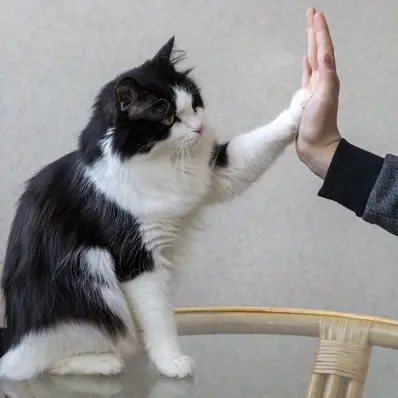What to Keep in Mind Before Training Your Cat?
Before diving into the exciting journey of training your cat, there are several crucial considerations to keep in mind.
- Patience is Key
Cats are known for their independent nature, and training may take time. Be patient, stay calm, and celebrate small victories. Positive reinforcement goes a long way in fostering a cooperative relationship.
- Understanding Your Cat’s Personality
Each cat is unique, with its own temperament and preferences. Tailor your training approach to match your cat’s personality, considering factors such as playfulness, shyness, or assertiveness.
- Create a Positive Environment
Choose a quiet and comfortable space for training sessions. Minimize distractions to help your cat focus, and ensure the area is free from potential stressors. A positive environment sets the stage for effective learning.
- Start with Basic Commands
Begin with simple commands like “sit” or “come.” Once your cat grasps these basics, you can gradually introduce more advanced tricks or behaviors. Building a solid foundation enhances the overall training experience.
- Use High-Value Treats
Find treats that truly captivate your cat’s taste buds. Reserve these high-value treats exclusively for training sessions to make the rewards special and motivating.
- Consistency is Crucial
Cats thrive on routine and consistency. Use the same commands and cues consistently, and establish a regular training schedule. This helps your cat understand expectations and promotes quicker learning.
- Respect Your Cat’s Limits
Recognize when your cat needs a break or is not in the mood for training. Pushing too hard can lead to resistance and stress. Respect your cat’s boundaries and adjust your training pace accordingly.
- Avoid Negative Reinforcement
Punishment can have detrimental effects on your cat’s trust and well-being. Instead, focus on positive reinforcement to encourage desired behaviors. Reward good actions and redirect unwanted behaviors without resorting to punishment.
- Make Training Enjoyable
Keep training sessions short, fun, and engaging. Incorporate play into the training routine to make it an enjoyable experience for your cat. This strengthens the bond between you and reinforces the positive aspects of learning.
How to Train Your Cat Using Various Training Methods?
When it comes to training your feline friend, various methods can be employed to achieve positive results. Here are some common cat training methods:
Clicker Training
Clicker training is a form of operant conditioning where a clicking sound is used to mark the exact moment your cat performs a desired action.
Paired with treats, the clicker serves as a clear signal that the behavior is correct, making it an effective method for teaching specific commands or tricks.
Litter Box Training
Teaching a cat to use a litter box is a crucial aspect of training. Place the litter box in a quiet, accessible location, and praise your cat when they use it correctly. Consistency is key to reinforcing this behavior.
Leash Training
Leash training allows you to take your cat outdoors safely. Start by introducing your cat to the harness indoors and rewarding them for wearing it. Gradually progress to short leash walks, providing positive reinforcement for good behavior.
Redirecting Behaviors
Instead of punishing undesirable behaviors, such as scratching furniture, redirect your cat to an acceptable alternative, like a scratching post. This method helps guide your cat’s natural instincts while preventing damage to your belongings.
Desensitization and Counterconditioning
This approach involves gradually exposing your cat to stimuli that may trigger fear or anxiety in a controlled and positive manner. By pairing the trigger with positive experiences, you can help your cat overcome fears and build confidence.
Target Training
Using a target, such as a stick with a soft tip, allows you to guide your cat to perform specific actions. This method is useful for teaching commands like “sit” or “jump” and enhances your cat’s focus and responsiveness.
Training Games
Engaging your cat in interactive games, such as puzzle toys or agility courses, not only provides mental stimulation but also reinforces positive behaviors. These games tap into your cat’s natural instincts and make learning enjoyable.
Basic Obedience Training
Basic obedience training involves teaching fundamental commands such as “sit,” “stay,” and “come.” These commands enhance communication between you and your cat, establishing a foundation for more advanced training.
Agility Training
Agility training involves creating an obstacle course to challenge and engage your cat physically and mentally. This type of training is not only fun but also helps improve coordination and keeps your cat active.
Socialization Training
Socialization training is crucial for kittens and newly adopted cats. It involves exposing them to various people, environments, and other animals to ensure they become well-adjusted and comfortable in different situations.
Strategies to Stop Unwanted Cat Behavior
Unwanted cat behavior can be challenging, but with the right strategies, you can effectively address and modify these habits. Here are some proven techniques to stop undesirable cat behavior:
- Identify the Root Cause
Before implementing corrective measures, understand the underlying cause of the behavior. Cats may act out due to stress, boredom, or health issues. Identifying the root cause is crucial for targeted intervention.
- Positive Reinforcement
Use positive reinforcement to encourage good behavior. Reward your cat with treats, praise, or affection when they exhibit desirable actions. Positive associations will motivate them to repeat these behaviors.
- Redirecting Attention
When you catch your cat engaging in unwanted behavior, redirect their attention to a more appropriate activity. Offer a toy, engage in interactive play, or provide a scratching post as an alternative outlet.
- Consistent Discipline
Establish consistent discipline methods. While positive reinforcement is crucial, providing clear boundaries and, when necessary, using a firm “no” or a gentle spray of water can deter unwanted behaviors over time.
- Create Enriching Environments
Boredom can contribute to undesirable behaviors. Ensure your cat’s environment is enriched with toys, climbing structures, and interactive activities. Rotate toys regularly to keep them interesting.
- Use Deterrents
Employ safe deterrents to discourage specific behaviors. For example, use double-sided tape on furniture to deter scratching or place citrus-scented items in areas you want to keep your cat away from.
- Provide Mental Stimulation
Mental stimulation is crucial for a cat’s well-being. Use puzzle feeders, treat-dispensing toys, or engage in interactive play to keep your cat mentally stimulated and less likely to engage in destructive behaviors.
- Establish Routine
Cats thrive on routine. Establish a consistent daily schedule for feeding, playtime, and rest. Predictability provides a sense of security, reducing stress-induced behaviors.
- Consult with a Veterinarian
If your cat’s behavior suddenly changes or if they exhibit signs of distress, consult with a veterinarian. Medical issues, such as pain or illness, can manifest as behavioral problems. Addressing the underlying health concern may resolve the behavior.
5 Cat Training Hacks You Should Know
Discovering effective and clever shortcuts can significantly enhance your cat training experience.
Here are five cat training hacks that can make the process more efficient and enjoyable:
- Scent Association for Commands
Cats have a strong sense of smell. Associate a specific scent with a particular command or behavior. For instance, use a scented spray on the scratching post or the litter box. Over time, your cat will associate the scent with the desired action.
- Training During Mealtimes
Take advantage of your cat’s natural eagerness during mealtimes. Incorporate short training sessions before meals to tap into their motivation. This can be an effective way to reinforce positive behaviors and create a positive association with training.
- Mirror Training for Mimicking
Cats can learn by observing. If you have a well-trained cat, use their behavior as an example for a new or younger cat. Place them together during training sessions, allowing the less experienced cat to mimic the trained cat’s actions.
- Incorporate Environmental Sounds
Introduce environmental sounds during training sessions to help your cat become accustomed to various stimuli. This can be especially beneficial for reducing anxiety-related behaviors. Start with low-volume sounds and gradually increase the intensity as your cat becomes more comfortable.
- Utilize Feeding Puzzles
Turn mealtime into a training opportunity by using feeding puzzles. These interactive toys not only provide mental stimulation but also encourage problem-solving. This can be particularly useful for diverting your cat’s energy into a positive and rewarding activity.
5 Reasons Why Cat Training Is Important
Cat training is not just about teaching tricks; it plays a crucial role in fostering a harmonious relationship between you and your feline companion.
Here are five compelling reasons why cat training is important:
- Behavioral Harmony: Training your cat establishes clear communication and mutual understanding. By setting boundaries and expectations, you create a harmonious environment where both you and your cat feel comfortable and secure.
- Reduced Stress: Cats thrive on routine and predictability. Training helps reduce stress by providing structure and consistency in their daily lives. This is particularly important for shy or anxious cats who benefit from a stable and reassuring environment.
- Enhanced Safety: Training your cat to respond to basic commands such as “come” or “stay” can be crucial in emergency situations. It ensures that your cat is less likely to engage in risky behaviors, making them safer both indoors and outdoors.
- Improved Health and Hygiene: Litter training is a fundamental aspect of cat training that contributes to a clean and healthy living environment. Training your cat to use a litter box promotes good hygiene practices and helps prevent issues related to inappropriate elimination.
- Strengthened Bond: Training sessions provide an opportunity for positive interaction and bonding between you and your cat. The trust and connection formed during training create a deeper and more meaningful relationship, enriching the overall quality of life for both you and your feline companion.




